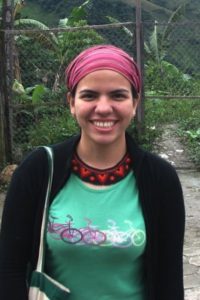Do you have any sense of how the pandemic is affecting conservation threats such as land grabbing, deforestation and fires in the Amazon region of your countries? Are threats increasing? Decreasing? Why?
There seems to be a disturbing synergism between COVID-19 and (dis)governance and this is consistent across Amazonian countries. COVID-19 is weakening already weak governance structures, and bad actors, both private sector and within government, are taking advantage to exploit and grab land and resources.
Loreto – Peru

I believe at this moment all illegal activities have increased (deforestation, fires, land grabbing, wildlife trade, illegal mining). I would say that COVID-19 has stressed the already weakened governance in this region. On top of all, or more like the core of all: corruption as a facilitator or driver, not sure.
The why’s remain the same (pre and post COVID-19): isolation and lack of proper knowledge – and the consequent care – of the region, especially from decision-makers. Before COVID-19 Loreto had an unprecedented dengue outbreak and did not receive the proper attention. Once COVID-19 arrived, it was as bad as you would expect.
With all the focus on health and its logistics to treat COVID-19, conservation threats and pressures were left aside, and I think all the weight of it fell on local (riverside) communities.
Southern Amazonas – Northern Rondônia
The absence of law enforcement, which was an issue already due to budget constraints, has increased due to the pandemic. Various NGOs, activists and local leaders have been reporting how illegal activities, land conflicts, killing of environmental activists and disrespect of traditional rights are increasing.
Many local partners report that deforestation, forest fires caused by human activities, illegal logging and mining, land grabbing, etc are significantly increasing, due to the sense of impunity and sponsorship from current government discourse, on top of the dismantlement of public policies. Satellite images have also confirmed the tendency of deforestation to increase.
Check out this great article recently published in Biological Conservation here. It was broadly covered by Brazilian media.
Colombian Amazon – Colombia

The situation here is awful…
In the regions, people report have increased taking advantage of the absence of government and governance that the Colombian State currently have.
The proliferation of threats from organized crime groups and the so-called FARC dissidents (guerrilla groups that did not demobilize) are becoming a new plague of violence. In many places, these groups have enforced their quarantine regulations on citizens, and non-compliance has led to the murder of people in Colombia.
The absence of the State is considered a government strategy by some analysts. The dispossession of land from peasants without property titles and threats to indigenous territories continues to be a successful strategy to unite small portions of land and convert them into pastures for extensive cattle ranching.
Deforestation and burning to expand the agricultural frontier have increased. Likewise, COVID-19 has reduced the operations of State offices, therefore the processes for collective land titling, which in theory would be able to stop dispossession, has been slowed down by the pandemic.
Upper Madera – Bolivia

In Bolivia, COVID-19 has negatively affected conservation actions in general. And the sad part is that it is not just illegal activities, also legal activities going off-limits, and in most cases, the government.
I have been in contact with protected area rangers, and they identify many external threats to protected areas in the Bolivian Amazon.
- Illegal logging, the Manuripi protected area is been suffering by Peruvians that are entering the area and doing illegal logging inside the protected areas.
- Other activities that have been increasing are illegal gold mining on the Madre de Dios River. There is a legal Bolivian concession that supposed to work upstream of the river, but outside the Manuripi PA limits, but they are starting to go inside the PA, and extracting gold illegally.
- The new government has been approving many «decretos» and laws against the protected areas in general. They are reducing rangers by more than half. And let them alone deal with illegals activities. Besides that, the government is reducing the budget for the protected areas.
There is not a bright future for conservation, unfortunately. We will see what happens next.
Questions for future work to help us think about possible medium and long-term impacts of COVID-19:
- Demographic impacts. Loss of elders represents a loss of knowledge, and accelerates a transition from older, more-traditional to younger more acculturated leadership. A loss of doctors and other health care workers. People with larger social networks, including leaders, may be more vulnerable.
- There may be cultural changes. Loss of traditional knowledge in rural areas. A potential incentive for reverse migration from urban to rural. Will there be other deeper changes in values, e.g. greater demand for government efficiency; prioritizing relationships over material goods?
- There may be a shift in the effectiveness of strategies given the rollback in legal frameworks and enforcement.
- NGOs roles and perceptions may change. To the extent that they adapt their programs and strategies to provide emergency assistance, will this change how the public sees them? How they see themselves? Will they have new capabilities and/or priorities?
- There may be new alliances.









